Kati Basti: Oil pooling Treatment For Low Back Pain
Article by Dr Raghuram Y.S. MD (Ay)
Low Back Pain is a common disease haunting the mankind for many centuries. All of us would have experienced a sore low back of various intensities at some point of our life. Modern day food and lifestyle activities, lowering immunity, frequency and mode of travel, many metabolic diseases like obesity etc, rush and push of life has been increasing the graphical picture and global incidence of low back pain. It is one of the top listed diseases for which the patients visit clinics to seek medical attention.
Low back pain or Lower back pain is a disorder involving the muscles and bones of the back. It affects about 40% of people at some point of their lives.
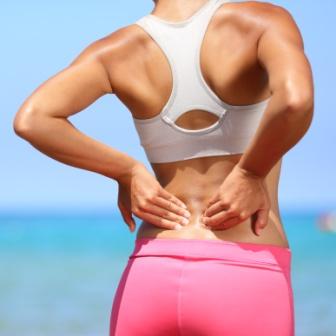
Ayurveda has the privilege of offering the best remedies for low back pain and related painful conditions. Among all the remedies available for low back pain, Kati Vasti (Kati Basti) is the most popular one. People who have experienced taking Kati Vasti would definitely tell you how they felt at the end of the course! It is not surprising if those undergoing Kati Vasti tell that they had almost forgotten that they had pain in their back! Such is the magic of this treatment.
Now let me take the privilege of introducing this treatment to you.
Table of Contents
Kati basti
What is Kati Vasti (Kati Basti)?
It has 2 terms –
Kati – means low back
Vasti – means to hold (compartment which holds)
Thus Kati Vasti means a treatment in which medicated oils are poured and pooled for a fixed duration of time in a compartment or a cabin constructed over the low back area using wet flour of black gram, covering the Lumbo-sacral and Sacro-iliac joints.
In simple words, Kati Vasti is pain relieving oil-pooling treatment conducted for low back pain.
Vasti or Basti is a term used to describe the urinary bladder in Ayurveda. Urinary bladder is a bag which holds urine for a certain amount of period till it is voided. Similarly in Kati Vasti a compartment is constructed over the low back area by using flour of black gram and the pain relieving medicated (herbal) oils are pooled in this compartment for a fixed duration of time. Therefore the procedure is called Kati Vasti.
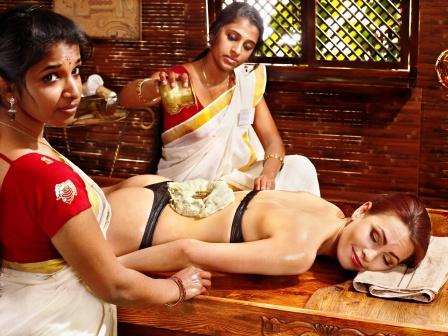
Indications
In which conditions is Kati Vasti beneficial?
Kati Vasti is highly beneficial in the below said conditions –
Low back pain (lower back pain / lumbago) – It is a common disorder of the lower back involving the muscles and bones of the back.
Lumbar spondylosis – This is a type of degenerative osteoarthritis of the joints of the bones forming your low back.
Sciatica – It is pain affecting the back, hip, thigh and outer side of the leg, caused by compression of a spinal nerve root in the lower back, often owing to degeneration of an intervertebral disc. Thus Sciatica is nerve pain from irritation of the Sciatic nerve. The pain along with tingling, numbness and weakness start in the lower back and travel downwards through the back of your thigh and outer side of the leg on the affected side.
Read related: Sciatica – Ayurvedic Understanding And Successful Treatment Options
Sacro-iliac joint pain or dysfunction – It is a disease of sacro-iliac joint which causes low back and or leg pain. The pain is typically felt when the dimples or pits (hollow) on either side of your lower back are pressed or compressed manually. The pain is as such experienced at the mentioned area and can spread down the leg and a little upward too.
Coccydynia – It is a medical term given to pain in coccyx or tail bone pain, usually brought on by sitting too abruptly. Read more about Ayurvedic treatment for coccydynia
Inter-vertebral disc prolapse (IVDP) or Lumbar disk disorders or spinal disc herniation – This is a frequent source of low back pain. In between every 2 vertebrae (bones making up your back bone) there is an inter-vertebral disc, a soft cartilaginous cushion which allows free movement of the spine (backbone). When these discs get bulged, protruded, extruded or sequestered, they press on a nerve root thus leading to pain and other symptoms in the leg.
Spodylolisthesis – It is a condition in which there is a forward displacement of a vertebra, especially the 5th Lumbar Vertebra. In this, there is general stiffening of the back, low back pain and tightening of hamstring muscles (muscles making the back of thigh), a leaning-forward pose (kyphotic), a waddle while walking (duck type walking) and a shooting pain along the course of sciatic nerve (involving pain in the back of thigh and leg)
Spina bifida (occulta) – It is a birth defect where there is an incomplete closing of the backbone and membranes around the spinal cord. It presents with leg weakness and paralysis, club foot, hip dislocation, bladder and bowel control problems etc
Read related:
Low Back Pain – Ayurveda View Point And Treatment
Back pain relief tips: How to strengthen lower back
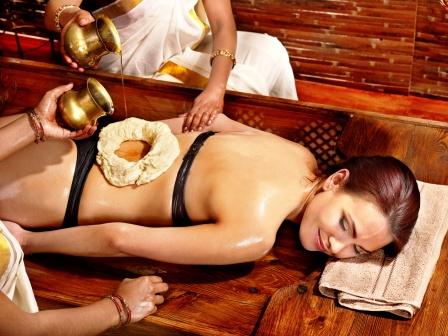
Procedure
How is Kati Vasti done?
Kati vasti is done in the below said method –
Purvakarma
Purvakarma (Pre-treatment procedures): This includes –
Preparation of the patient:
- The patient is thoroughly examined. The Prakriti (basic constitution) and Vikriti (details of morbidity) are documented in detail. The disease is also examined. The treatment line-up, materials and medicines which need to be used are enlisted.
- Patient is given a Sadhyo-virechana (instant purgation) for detoxification. This will also evacuate the bowel and reduce the pressure over the back and thus enhance the effect of Kati Vasti treatment.
Preparation for the treatment:
Materials needed for the treatment are collected beforehand. They are:
- For Kati Vasti (oil pooling) – Taila (medicated oil), Ghee (medicated ghee) or both suitable to the disease and diseased are collected and stored beforehand. The same medicines are used for conducting Abhyanga (massage) after the completion of Kativasti procedure
- Flour of black gram
- Water
- Stove, bowls, vessels, spoons etc
- Sterile cloth
- Herbal powders like – Rasnadi Churna, Kottamchukkadi Churna, Jatamayadi Churna, Ellumnishadi Churna, Grihadhoomadi Churna, Kolakulattadi Churna etc are collected for Churna Pinda Sweda (Powder bolus fomentation).
Churna pinda sweda is administered for a couple of days before starting Katibasti as a part of pre-treatment procedures. This aims at causing Rukshana (drying therapy) before conducting Kativasti. Kati Basti is a sthanika sneha procedure (local oleation). Kati Vasti or oil pooling is said to provide extra-ordinary relief if done on a dry surface of back, dryness being created after conducting Rukshana procedure.
Method of Churna pinda sweda – The above mentioned herbal powders are chosen according to the nature of the disease, symptoms and dosha involvement. Ex. Rasnadi churna is used when pain predominates, Jatamayadi churna is used when inflammation predominates etc. The powder is heated on a pan and tied in a sterile cloth so as to form a bolus. A couple of such boluses are kept ready.
After giving a massage to the low back with herbal oils, hot fomentation is given with the powder boluses. This brings about Rukshana (dryness). The powder should be used in a dry form if symptoms of ama (metabolic wastes created by low metabolism and indigestion which have a sticky nature and has a tendency to produce pain and stiffness) and morbid kapha like pain, stiffness, swelling etc are found in the low back. If the pain is of a dry nature with the involvement of morbid vayu, the powder may be heated by frying it in oil and used for panda sweda.
Churna pinda sweda is done for 30-45 minutes daily for 2-3 days prior to Kati Basti.
Materials needed for Udwarthana – Powders like Kolakulattadi Churnam etc, oils (same oils used for abhyanga can be used) etc
Udwarthana means massage conducted by using powders fried in medicated oils, the massage being done in reverse direction (from below upwards). This is preferred when symptoms of excess ama and or kapha or meda (fat) is found associated with low back pain.
- Fresh leaves of pain killing and vata alleviating drugs like Eranda (Ricinus communis – castor plant), Nigundi (Vitex negundo), Arka, Chincha (tamarind), etc. for conducting Patra panda sweda (leaf bolus fomentation) as a part of post-treatment procedure.
- Lemon, coconut gratings, Rasnadi Churna, Haridra (Turmeric powder), Methika (fenugreek), Saindhava Lavana (rock salt), Eranda Taila (castor oil) etc for patra pinda sweda
- In some cases, Kati Vasti can be clubbed with Matra Vasti (oil / ghee enemas given in a fixed dose, everyday). If this is planned, the medicated oil / ghee and enema syringe should be kept ready.
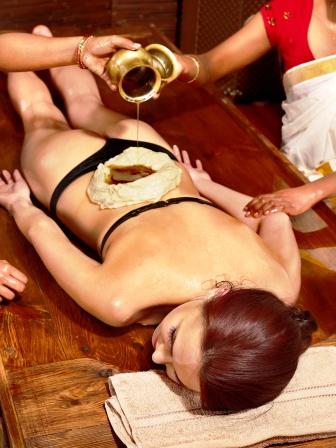
Click to Consult Dr Raghuram Y.S. MD (Ayu)
Pradhana Karma
Pradhana Karma (Treatment proper) – Kati Vasti –
Positioning of the patient:
Kati Vasti is done in the morning when the Kapha symptoms is predominate in the low back (stiffness), in the noon when pitta symptoms predominate (inflammation, burning sensation etc) and in the evening if Vata symptoms predominate (pain). Generally it is done early in the morning if patient is convenient.
The patient is asked to come or attend the treatment on empty stomach because while doing Kati Vasti, the patient has to sleep in prone position (on stomach).
The patient is positioned and made to lie on his belly on a comfortable couch
Preparing the wet flour for the treatment:
Finely pounded black gram flour is taken in a sterile bowl or vessel. Water is added to it (preferably warm water) and kneaded well so as to prepare a bolus.
Preparation and construction of Kati Vasti ring / compartment:
From this bolus a ring is made. The ring should be having a diameter so as to accommodate and enclose the lumbar vertebrae (low back bones), the sacroiliac joints and coccyx (tailbone) within it. That means to tell that when the ring of wet flour is placed on the back, the above said structures of the back are enclosed within the ring. The height of the ring should be at least 5-6 inches. The junction of the ring and skin is sealed with wet flour. A small amount of oil is now poured in the ring (compartment) of flour and checked for leakage. Kati Vasti should be started after confirming that there is no leakage at the base of the walls of the ring.
Method of oil pooling:
The chosen medicated oil is heated passively. Required quantity of oil (sufficient enough to fill the space within the ring of wet flour) is taken in a small bowl. The bowl is kept in the vessel filled with hot water. When the oil gets warm, the bowl is removed. Oil is poured into the compartment (space within the constructed ring of wet flour).
Recycling the oil:
Care should be taken to maintain the temperature of the oil in the Kati Vasti pool. The temperature should be kept uniform throughout the procedure (until the procedure is completed). For this to happen, the oil from the pool is removed at regular intervals (leaving some oil in it i.e. oil should not be completely removed) and replaced by warm oil (on the other side, simultaneously oil is passively heated).
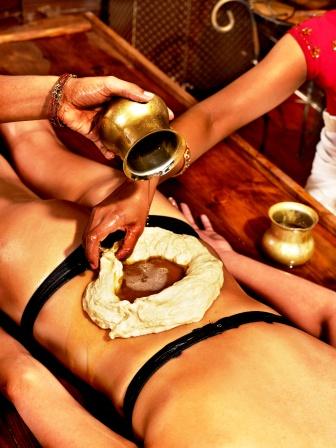
Oils / ghee used for Kati Vasti / Abhyanga:
- Ksheerabala tailam
- Mahamasha tailam
- Mahanarayana tailam
- Kottamchukkadi tailam
- Balashwagandhadi Tailam
- Ashwagandhabalalakshadi Tailam
- Sahacharadi tailam
- Murivenna
- Pinda tailam
- Tiktaka ghritam
- Guggulutiktaka ghritam
- Tila taila (sesame oil) etc
Paschat karma
Paschat Karma (Post-treatment procedures):
Removal of oil and flour cabinet:
At the end of fixed duration meant for completing a schedule (30-45 minutes roughly) the oil is slowly removed from the pool and stored in a container or bottle. On the next day, the same oil shall be reused after adding some more oil to replace the quantity consumed for treatment procedures on the previous day. The whole oil shall be replaced on the 4th day of the treatment. Actually it is good to take new oil every day but practically it becomes unaffordable from the patients perspective. The flour cabinet (kativasti ring) is also removed thoroughly.
Abhyanga –
A light massage is given using the same oil for 10-15 minutes. Care should be taken not to apply more pressure while massaging. The lower limbs and feet also shall be covered in the massage (optional).
Patra Pinda Sweda – Leaf bolus fomentation
The fresh leaves of the Vata alleviating / pain relieving herbs are collected and sliced. Ex. Leaves of Eranda (Ricinus communis – castor plant), Nigundi (Vitex nigundo), Arka (Calotropis gigantean), Chincha (tamarind), Shigru (Moringa oleifera – Drum stick leaves), Dhattura (Datura stramonium), Agnimantha (Clerodendrum phlomidis), etc are taken and sliced. The sliced leaves are fried in oil (oil taken for Kati Vasti). Along with the leaves, grated coconut, sliced lemon, Rasnadi Churna, Haridra (Turmeric powder), Methika (fenugreek), Saindhava Lavana (rock salt), Eranda Taila (castor oil) are also added and fried. The sliced leaves are tied in a bolus to form a Patra Pinda (Leaf bolus). A couple of boluses are prepared
The leaf bolus is dipped in warm oil, any oil drooping from the bolus is mopped over the edge of the pan, and temperature of the bolus is tested and used for giving fomentation. The bolus is rubbed on the affected part gently (as good as massaging with bolus). Circular motions with gentle pressure is given over the joints and rubbed vertically from above downwards while giving fomentation over muscles (in the direction of muscles).
Once the bolus loses its temperature, it should be replaced with other bolus which has been kept dipped in the oil in the heated pan. The fire beneath the pan should be constant (mild flame) until the treatment is completed. The boluses are thus changed one after the other until the procedure is completed.
After the completion of treatment, the residual oil etc are cleansed with the help of a tissue paper or vata alleviating leaves or with sterile cloth / cotton dipped in warm water.
- Shashtika Shali Pinda Sweda – Fomentation with Shashtika Rice (rice grown in 60 days duration) processed with medicinal decoctions packed in boluses shall be preferred as a combined therapy for Kati Vasti when there are signs of severe Vata vitiation and degeneration of tissues and when nourishment seems to be in demand as far as the low back is concerned.
- Snana – Bath
The person is allowed to rest for about 1 hour and later advised to take hot water bath. He should be using green gram powder to rub his body, Siddhartha Snana churna (bathing powder) or any herbal powder can also be used alternatively. If the patient is being treated as outpatient, the patient is advised to take a bath at home after an hour or couple of hours.
Matra Basti –
Vasti (Basti) – medicated Enema’s are the best to control morbid Vayu and hence the painful conditions caused by it, including low back pain.
Matra Vasti is a subtype of Vasti procedure wherein a small quantity of enema using medicated oil or ghee or a combination of both is given daily. Usually 50-75 ml is given after food.
Medicines used for Matra Vasti – Guggulutiktakam Ghritam, Mahanarayana Tailam, Sahacharadi Tailam, Dhanwantaram tailam / mezhupakam etc
Matra Vasti is given on all days of Kati Vasti
Nitya Virechana – Daily metered dose of purgation with purgative decoctions or oils like Gandharvahastadi Kashayam, Gandharvahastadi Eranda tailam, Nimbamritadi Eranda Tailam etc can be administered if a small amount of detoxification is essential on a daily basis or if morbid Vata and Pitta need to be tackled (optional and strictly based on the decision of the doctor). This can be thought of when Virechana is needed during treatment. Nitya Virechana can also be a part of follow up. Nitya Virechana should never be administered when Matra Vasti is planned in the protocol of treatment. In such cases, Matra Vasti can be given during the schedule of Kati Vasti and Nitya Virechana, if needed can be brought in the follow up seeing the morbidity of Vata and Pitta.
Nitya Virechana and Matra Vasti – They also cleanse the bowel and bladder, thus minimising the pressure of bowel and bladder on low back.
Discharge – The patient is discharged on daily basis (out-patient) or after the course has been completed (in-patient) after giving proper lifestyle and diet advises along with suitable medicines (oral). The patient is also advised to undergo the treatment twice or thrice in a year as a part of maintenance and to avoid recurrence. Chronic diseases if any should be attended by prompt intake of medication. Obesity is one of the main concerns and risk factor for low back pain and arthritis. Correction of constipation and menstrual disorders in women also should be focused upon. Regular exercises should be added with a planned diet to reduce weight.
From my clinical experience – Dr Raghuram
Some physicians like to tend the process after finishing Kati Vasti without touching or extending it to Abhyanga, Patra pinda sweda and Vasti. But with my clinical experience, I think that it is not a problem combining therapies for giving a better relief. Whenever I have combined Kati Basti with Patra Pinda Sweda or Matra Vasti, the results have been outstanding. But again the nature of the disease and the predominance of the Dosha and affordability of the patient should be considered. There are no fixed rules for carrying on the treatments, the only rule is that things should not be overdone or underdone and the relief of the patient is the most important motive. Ayurveda has given us a liberty to experiment (Yukti).
Duration of the course –
The number of days of treatment varies from 7-14 days depending on the nature and intensity of the disease
Treatment (only Kati Vasti) is done for a period of 30-45 minutes per session (Treatment duration will extend beyond this if it is combined with other treatments mentioned above)
Ayurvedic medicines
Medications low back pain (Kati Shula), Low back stiffness (Katigraha), Sciatica and other forms of back pain –
Kashaya’s (Herbal decoctions):
- Rasnasaptakam Kashayam
- Rasnapanchakam Kashayam
- Dhanwantaram Kashayam
- Sahacharadi Kashayam
- Sahacharabaladi Kashayam
- Amrutottaram Kashayam
- Guggulutiktakam Kashayam
- Kokilaksham Kashayam
- Guluchyadi Kashayam
- Gandharvahastadi Kashayam
Ghritam and Tailam (medicated ghee and oils):
- Guggulutiktakam Ghritam
- Varanadi Ghritam
- Rasnadi Ghritam
- Dhanwantaram Ghritam
- Tiktakam Ghritam
- Ksheerabala Tailam
- Sahacharadi Tailam
- Ksheerabala tailam 101
- Dhanwantaram tailam 101
Asava / Arishtam:
- Dashamularishtam
- Abhayarishtam
- Ashwagandharishtam
- Balarishtam
- Dhanwantararishtam
- Devadarvarishtam etc
Vati and Gulika (Tablets):
- Trayodashanga Guggulu
- Rasnadi Guggulu
- Simhanada Guggulu
- Navaka Guggulu
- Kaishora Guggulu
- Yogaraja Guggulu
- Panchatikta Ghrita Guggulu
- Ekangaveera ras
- Mahavata vidhwamsini rasa
- Vatagajankusha rasa
- Ksheerabala Tailam 101 caps
- Dhanwantaram Tailam 101 caps etc
External applications:
The same herbal oils mentioned in Abhyanga etc. can be used for external application.
Benefits of Kati Vasti
- Relieves pain in the low back and lower limbs
- Relieves stiffness in the low back and lower limb
- Relieves swelling and inflammation in the low back, in the bones and soft tissues of the low back
- Brings lightness and a sense of health in the lower portion of the body
- Improves mobility of the back and lower limbs and enable us to move and work freely
- Strengthens the low back (bones, muscles and soft tissues therein)
- Soothes the nerves supplying the low back and legs (lower limbs)
- Enhances blood supply to the low back area
Probable mode of action
Almost all pains are caused due to –
Aggravation of Vayu (mainly degenerative types of pain) – This further leads to depletion and degeneration of tissues
Avarana of Vayu (enveloping of smooth functioning of Vayu by one or the other element of the body including Pitta, Kapha, Dhatus – tissues, etc)
Ama – Sticky toxins produced as a result of low digestion (gut and cellular) which hamper the smooth functioning of Doshas and Dhatus and block the excretion of body wastes by blocking them.
High Pitta can cause inflammatory type of pain in the low back and also in lower limbs
High Pitta can cause stiffness and loss of movements in the low back
Udwarthana and or Churna Pinda Sweda done before Kati Vasti would dry up ama and kapha, liquidity of pitta (sama pitta) and relieve stiffness and loss of movements. Kati Vasti nourishes the joints of the low back, pacifies the dosha causing pain or discomfort (by using ideal oils), soothes the nerves, relieves degeneration, stiffness and inflammation and cures pain. Patra Pinda Sweda further rejuvenates the back by controlling Vayu. Shashtika shali pinda sweda strengthens and nourishes the low back and limbs. Virechana detoxifies the system and relieves inflammation and Vasti drives the morbid Vayu out of the system and fortifies the cure. Vasti and Virechana also help in removing the avarana of Vayu and also in preventing the recurrence of low back pain. Vasti and Virechana also normalize the functions of Apana vayu, thus correcting all the functional aspects of the lower body under its governance.
Modern mode of action –
Oil and herbal active principles get absorbed through skin medium.
The hot oil also helps to improve the gap between the vertebrae, thus giving a chance for the herniated disc to heal.
It is not mandatory to combine all the treatments at a time but it is left to the wisdom of the Ayurvedic doctor attending your low back and the diagnosis he or she has done after examining you.
To sum up,
Kati Vasti is the best treatment which Ayurveda provides to heal your back pain. All you need to do is to meet an experienced Ayurvedic doctor and put forth your problems. The doctor will help you to get your sore back into its rhythm.
The beauty of Kati Vasti is that it can even be administered on healthy individuals and health freaks. Thus Kati Vasti forms an important part of prophylactic back care, a part of ‘prevention is better than cure’ mantra.
If you have occasional back pain, you are having a platform for a more serious one. If your job and posture are bad enough to predispose for recurrent episodes of backache, you need to take preventive ‘Kati Vasti’ sessions. In this your doctor may advise you to take Kati Vasti and Patra Pinda Sweda once (one day) a month or twice a month, say on alternate Saturday’s or Sunday’s.
Isn’t it good news to all of you?
So whenever you have a back pain, think of Kati Vasti
Click to Consult Dr Raghuram Y.S. MD (Ayu)









9 comments
T Mistry
A very good article
Q What are the benefits of Lotus seeds as chinese use them lot please let me know
Dr J V Hebbar MD(Ayu)Author
Read about it here – https://www.easyayurveda.com/2015/03/11/lotus-benefits-side-effects-research/
Amit
Sir kindly tell me Kati vasti fees for 7/14/21 days of treatment.
Thanks
Dr J V Hebbar MD(Ayu)Author
It depends from center to center. Contact an Ayurveda clinic directly.
Deepak
I have a both hips prob..is that kati basti is the teratment or not
Dr J V Hebbar MD(Ayu)Author
Depends on what exactly is the hip problem. Please consult an Ayurveda doctor directly.
vijayakumar
Dear Doctor
How KATI VASTI can rejuvenate Herniated disc or heal a pinched nerve root
Dr J V Hebbar MD(Ayu)Author
Oil and herbal active principles get absorbed through skin medium.
The hot oil also helps to improve the gap between the vertebrae, thus giving a chance for the herniated disc to heal.
Dr J V Hebbar MD(Ayu)Author
Kati Basti could be useful.